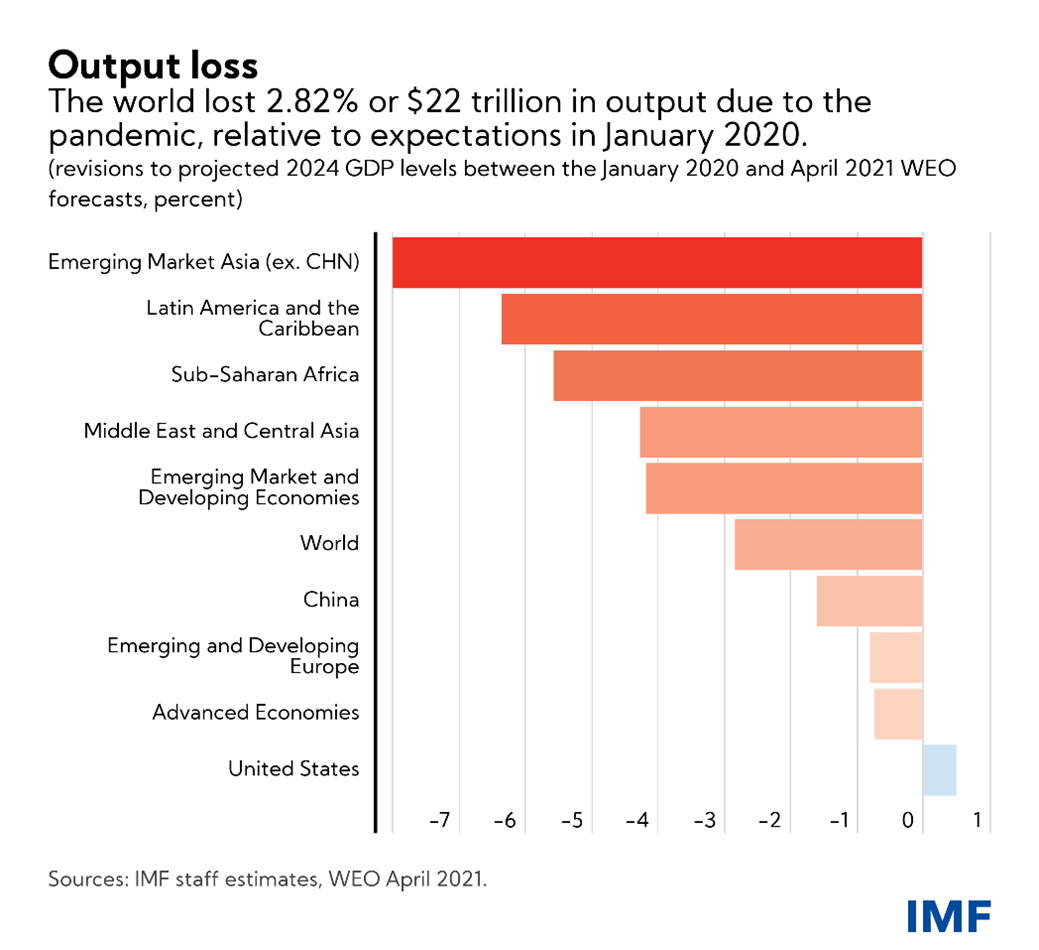|
Dear Colleague,
We recently published a new blog—please find the full text below. Translations coming soon.
Seizing the Opportunity for a Pro-Growth, Post-Pandemic World
By Geoffrey Okamoto
Since March 2020, governments have spent $16 trillion providing fiscal support amid the pandemic, and global central banks have increased their balance sheets by a combined $7.5 trillion. Deficits are the highest they have been since World War II and central banks have provided more liquidity in the past year than in the past 10 years combined. This was absolutely necessary — IMF research indicates that if policymakers had not acted, last year’s recession, which was the worst peacetime recession since the Great Depression, would have been three times worse.
That’s where we’ve come from, but where are we headed? In the year ahead, as more vaccines roll off the production line, more people get jabbed, and more economies gradually reopen, policymakers need to engineer a fundamental shift from saving their economies from collapse, to strengthening their economies for the future with growth-oriented reforms.
We know that some pro-growth reforms were deferred, if not reversed, and some economic scarring has occurred. The world lost $22 trillion in output as a result of COVID-19, relative to what the IMF expected in January 2020. The same energy that is being put into vaccination and plans for recovery spending also needs to be put into growth measures to make up for this lost output.

Enhanced debt restructuring mechanisms should help resolve unviable firms expeditiously and channel investment to new ideas and companies. Stronger active labor market policies, including job-search monitoring and support, and retraining should help workers shift to more promising jobs in dynamic parts of the economy. Improved competition policy frameworks—actively debated right now in Europe and the United States—and reductions in barriers to entry in sclerotic sectors should ensure that we don’t have moats around the firms that captured the policymakers of yesteryear.
Toward a brighter future
Using this moment for some of these difficult reforms means that the monetary and fiscal stimulus still flowing will serve as a springboard to a brighter and more sustainable future rather than a crutch to a weaker version of the pre-COVID-19 economy. Seizing the opportunity could deliver years of solid post-COVID-19 growth and progress in living standards. The IMF estimates that comprehensive growth-enhancing reforms cutting across product, labor, and financial markets could raise annual growth in GDP per capita by over one percentage point in emerging market and developing economies in the next decade. These countries would be able to double their speed of convergence to advanced economies’ living standards relative to the pre-pandemic years.

For advanced economies, a growth-reform tailwind would help repay the debts incurred to provide unprecedented support, increasing the space for critical investment and reducing the need to raise taxes. With inflation running higher than forecasted and the lack of certainty about when its drivers will abate, growth reforms that target the supply-side provide insurance against any persistent inflationary risks from demand-side pressures in the United States and elsewhere.
For emerging market countries that have been able to maintain access to global capital markets, reforms can strengthen fundamentals and bolster investor confidence even as financial conditions tighten, especially if inflation persists in advanced economies. For low-income countries who have depleted their policy space, the returns on growth-oriented reforms can be high enough to avoid harsh fiscal austerity, allowing them to protect social and health spending in the short-run while boosting their capacity to invest in their people in the long-run.
It doesn’t all have to be done at once. Recovery from this crisis will take years for most countries. Inspiring the next generation to rebuild a brighter future is the primary challenge for this generation of policymakers. They should seize this challenge, daring to be bold as the current crisis reaches a crossroads. Pairing growth reforms with recovery spending will deliver the prosperity that we have promised our citizens, making our own fate in a post-COVID-19 world.
Geoffrey Okamoto is First Deputy Managing Director of the IMF.
*****
We want to hear from you! Click here for a 3-question survey on IMFBlog.
Thank you again for your interest in IMF Blog. Read more of our latest content here.
Take good care,
P.S. Are you on LinkedIn? Subscribe to our new Weekend Read visual newsletter.
_____
Surprise a colleague: forward this email
First-time reader? Sign up here
Update your profile for tailored content
View all IMF newsletters
Unsubscribe from IMF Blog here
|